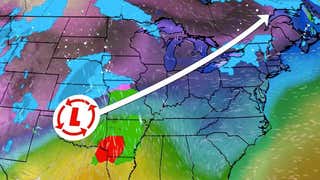

US
°C





The Itaipu hydroelectric plant is just one of the 191 dams already built on the Amazon basin.
(Christian Rizzi/AFP/Getty Images)
The Amazon basin's abundance of dam building projects are threatening to extinct "countless" unique animals and plants, a new study claims.
While the Amazon makes up nearly a fifth of all water given off by rivers across the globe, the dam system may not be as green as it may seem on paper, says a new study in Biodiversity and Conservation.
Hundreds, if not thousands of localized species call the Amazon rainforest home, some ranging a scarcely small area. With the construction of more and more dams being built, the known habitat for some species could disappear and wipe them out for good.
The Sao Simao reservoir, created by a hydroelectric plant, spans 231,660-square-miles in Brazil.
(NASA)
“The rivers that run across these tropical forest landscapes are home to many endemic species – species that are found nowhere else. Some of them are restricted to isolated sections of rapids only a few tens of kilometres in length,” said lead researcher Carlos Peres, a professor from the University of East Anglia.
One hundred and ninety-one dams have already been built on the Amazon across nine countries, not to mention the additional 243 that are in the works, says Blue and Green Tomorrow.
“Our research shows that an expansion of the dam network will result in huge changes to these Amazonian rivers by obstructing movement of aquatic fauna both upstream and downstream, by submerging rapids under huge lakes, by flooding adjacent forests and by creating forest islands that cannot sustain viable animal and plant populations,” said Peres.
Many of the species that could be negatively affected as a result of dam expansion are protected against international trade. However, there’s nothing to protect them if their habitats are destroyed by renewable energy projects.
This isn’t the first time that a dam’s ecological prowess has been questioned. The Ballina Dam in Brazil significantly reduced the number of species living in the area, according to a study published in PLoS One.
Hydroelectricityhas also been known to be large contributors CO2 and methane emissions, causing nearby trees to rot and decompose.
(More:Man-Made Climate Change is Fueling Extreme Weather Events)
In 1990, the greenhouse effect of emissions from the Curuá-Una dam in Brazil was an estimated three-and-a-half times more than what they would’ve been by producing the same amount of electricity from oil, according to New Scientist.
These type of harmful emissions carry an even heavier impact in tropical regions with temperatures favoring the formation of methane and rapid decomposition.
“The change from fast-flowing to still waters after river impoundment likely favours generalist or invasive species over the specialist and often micro-endemic species that require fast-flowing rivers and exposed rocky islets,” said Dr. Alexander Lees of the Cornell Lab of Orthinology.
“This loss, degradation and fragmentation of habitats will eventually lead to a large loss of regional biodiversity and a simplification of the community of species.”
MORE ON WEATHER.COM: The Amazon Rainforest
Aerial view taken on October 3, 2008 over the French Guiana's Amazonia, its rainforests contain a tenth of all the CO2 stored on Earth's land surfaces. (JODY AMIET/AFP/Getty Images)












